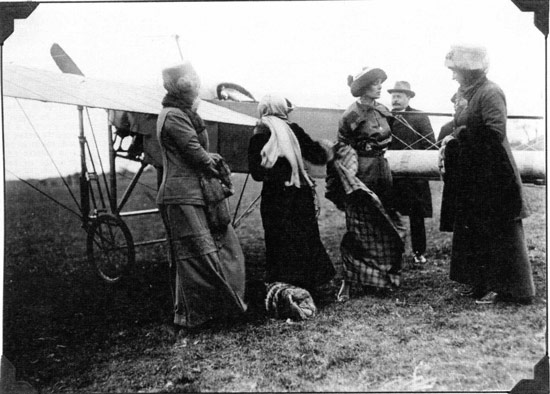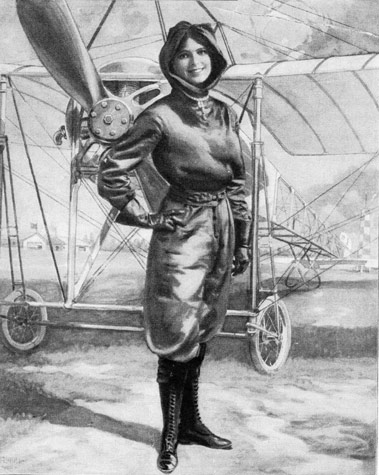|
8/16/12
A RACER AT HEART
Not long ago someone asked me to name someone
– anyone, from any period in history – whom I’d put in my race car
if we were into superspeedway racing.
Interesting question.
It’s quite apparent that success in that arena these days involves a
lot more than athletic talent with a super-sized side of bravery.
The key ingredients seem to include comfortable access to money and
the media, and a pleasing physical appearance.
So here’s our
candidate: the glamorous and gutsy Harriet Quimby.
Ms.
Quimbly was born on a Homestead Act farm in Michigan in 1875. It was
just too early for her to become a race car driver, but she sure
bounced along that wall along the way.
Uncommonly beautiful
and adventurous from the start, Harriet was intent on becoming a
silent-screen actress after her family moved to California in her
early twenties. She did manage a film role here and there, but
settled in as a screen writer – and a prodigious photo journalist
for Leslie’s Weekly Illustrated. Her popularity soared and, by the
time she moved to the Big Apple, she was an aspiring socialite, best
friend of Carrie Vanderbilt, and a fixture in Bohemian and artistic
circles as well.
Harriet traveled far and wide with her note
pad – Cuba, Egypt, Iceland, Mexico. She really became mobile,
though, following an assignment to cover the Vanderbilt Cup Races in
October of 1906. And, wouldn’t you know, she got a ride…as a
passenger in Herbert Lytle’s Pope-Toledo. It captured her, hook,
line, and sinker. She wrote of her adventure:
You will
remember many a day how the automobile seems to fly…at a trifle over
100 miles an hour. Although every nerve in your body is quivering,
you manage to shout an answer to Lytle, who asks with exquisite
sarcasm, at the top of his voice, ‘Was that fast enough?’ and you
enjoy the satisfaction of seeing him nearly fall over with surprise
as you fire back, ‘Twasn’t very fast; can’t you make it 120?’
In no time she was tootling all over hither and yon in her own
car, penning articles about automobiles and their repair. The only
exercise she seemed to find a challenge was mounting tires.
But it was actually at another assignment that Harriet really took
off. That was covering the 1910 Belmont Air Show and its airplane
race around the Statue of Liberty. Determined to learn to fly as
well as any man, she breezed through her training and became
“America’s First Birdwoman,” our first licensed female pilot.
She quickly rose to meteoric fame and a huge draw at fairs
nationwide. With characteristic feminine flair, she would fly with a
colorful scarf trailing behind. Soon, though, she had to design new
clothing to overcome such obstacles as revealing an ankle as she
climbed into the fuselage. The result was a daringly fashionable
purple flying costume.
In 1912 she boarded a steamer for
England for a stunt foretelling Evel Kneivel. Lifting tentatively
out of an aerodrome in Dover on April 16, she became the first woman
to fly the English Channel. Though publicity for her accomplishment
was muted by word of the Titanic’s sinking the previous day, Harriet
was on top of the world. The only unsettled issue may have related
to rumors of two devastatingly failed affairs. She never married.
 |
Harriet preps for
her flight across the Channel. Note the pontoon that
plane
builder Louis Bleriot strapped on inside
the fuselage in case of a “watery
landing.” From The Harriet Quimby Scrapbook, by
Giacinta Bradley Koontz.
(Carrie Vanderbilt
Collection) |
|
And then came Boston. On July 1,
1912, Harriet, as the grand attraction, came to the third annual
Harvard Aviation Meet. In a pre-show exercise, she went aloft with
the promoter, William Williard, for a ride around Boston Light in
the harbor. All was well until suddenly, still over the water but in
full view of the spectators, the two-seater Bleriot pitched forward
violently. There were no seat belts, and Williard was tossed out.
Moments later, Harriet followed, her purple suit arcing helplessly
against the blue summer sky.
The remains of the plane were
recovered from a mud-bog and rest today at the Old Rhinebeck
Aerodrome in New York’s Catskill Mountains, across the river from
Accord Speedway.
She could have driven our car anytime.
 |
| Leslie’s Weekly
Illustrated’s publicity illustration of their
journalist, Harriet. |
|
© 2012 Lew Boyd, Coastal 181
If you were interested in this
Tearoff, you might enjoy the books below:
|